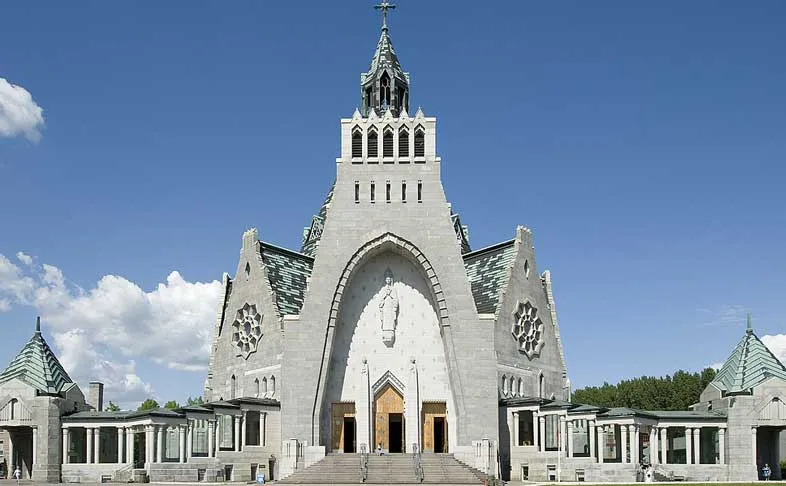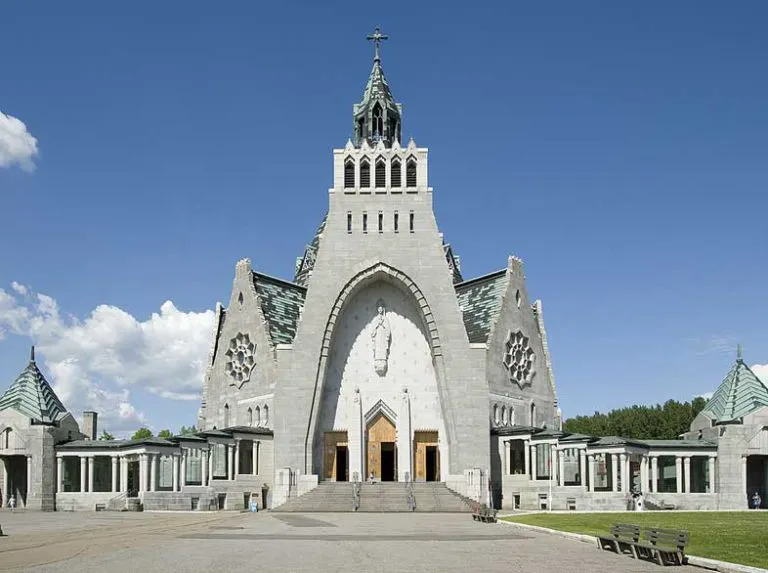
Introduction
Sanctuaire Notre Dame Du Cap also known as Our Lady of the Cape Shrine is Canada’s National Shrine to Our Blessed Mother. It is located at Trois-Rivières, in the district of Cap-de- la-Madeleine, half-way between Montreal and Quebec City. The shrine is one of five national shrines in Canada.
Our Lady of the Cape Shrine is the second largest Marian Shrine in North America. Founded in 1888, the Shrine attracts yearly more than 430,000 visitors.
The first church in the district of Cap-de-la-Madeleine was a small wooden structure built in 1659. In 1694, the first resident pastor, Father Paul Vachon, established the Confraternity of the Most Holy Rosary at Cap de la Madeleine. The wooden building was replaced by a fieldstone church in 1720. The hand hewn beams from the wooden church were used in the construction of the new stone church. Canon Vachon died in 1729 and is buried in the church.
For a long time the parish was without a resident pastor and fell into neglect. In 1867, Father Luc Desilets, pastor at Cap-de-la-Madeleine, re-introduced the praying of the rosary and promoted it among his parishioners. A more regular pastoral presence resulted in increased attendance, and a larger church was needed.
History of Sanctuaire Notre Dame Du Cap, Trois-Rivières
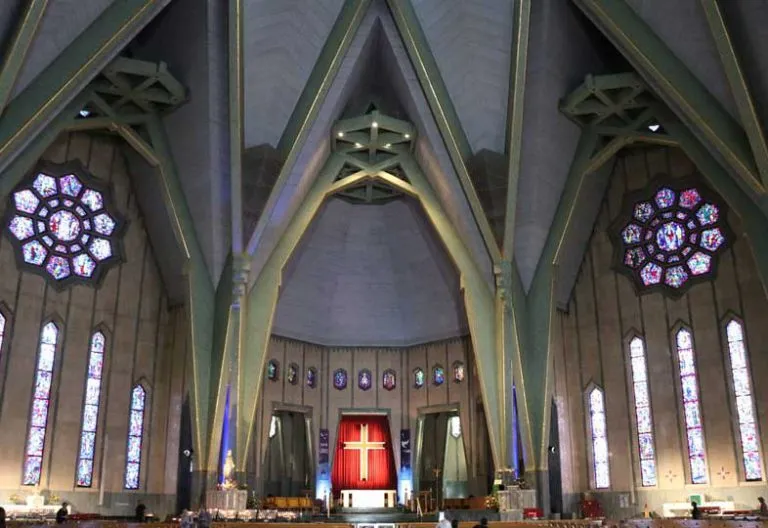
Construction of a new church was hampered by the difficulty of transporting material. However, in mid-March 1879, despite it being an unusually mild winter, a small section of the St. Lawrence River froze sufficiently that, by adding additional snow and water, Father Louis-Eugene Duguay, and some parishioners were able to construct a narrow mile-and-a-half long ice bridge.
The ice held for a full week and allowed the building material to be hauled across on horse-drawn sledges. The people attributed their success to the intercession of the Blessed Mother. In October 1880 the finished third church was dedicated to Sainte-Marie-Madeleine.
True to a promise made to the Blessed Virgin, instead of demolishing the old stone church, Desilets dedicated it to Our Lady, Queen of the Most Holy Rosary. The first pilgrimage to the Sanctuary was made on May 7, 1883. Desilets died shortly thereafter, and Duguay became pastor. Janssoone took over the responsibility of managing the shrine, and installed a Way of the Cross. Bronze statues depicted the stations.
As the parish work and number of pilgrims increased, they asked the bishop to appoint a custodian to take over the shrine. In 1902, the Missionary Oblates of Mary Immaculate became guardians of the Shrine. Beginning in 1906, they installed a Way of the Rosary. The path leads to a series of bronze statues, cast in France, each representing one of the fifteen traditional mysteries of the rosary.
In October 1904, Pope Pius X authorized the canonical coronation of Our Lady of the Cape. In 1964, the present basilica was inaugurated, and the sanctuary officially became a minor basilica. The Missionary Oblates of Mary Immaculate continue to operate the shrine.
Pope John Paul II visited in September 1984. Father Janssoone was declared blessed by Pope John Paul II on September 25, 1988.
The church that was completed in 1888, was demolished in 1963 to make way for the square in front of the present basilica. Some of its stones were kept to make an addition to the first church in 1973. The basilica, designed by architect Adrien Dufresne, opened in 1964 and can accommodate up to 1,660 people. Reinforced concrete arches outline the building. The Casavant organ consists of 5,425 pipes. The stained glass windows are by Dutch Oblate Father Jan Tillemans.
Our Lady of the Cape

Our Lady of the Cape (Notre-Dame-du-Cap in French) is a title given to Mary the Mother of God in Cap-de-la-Madeleine, Quebec Canada. The title refers specifically to a statue of the Blessed Mother which is currently located in the Old Shrine.
Pope Pius X granted the venerated image its canonical coronation on 12 October 1904 while Pope Pius XII sent another ceremonial coronation on 15 August 1954.
Deep Marian Devotion existed in Cap-de-la-Madeleine since 1694 with the institution of the Brotherhood of the Rosary under Father Paul Vachon. In 1720, Father Vachon built a small fieldstone church to replace an earlier wooden structure. Father Vachon died in 1729, and was buried in the church. Without a resident pastor, the parish fell into decline. It was not until 1845 that the Bishop appointed Fr. Leandre Tourigny to be the settlement’s resident priest.
In 1867, devotion to Mary was revived under Father Luc Desilets. After he had been deeply disappointed seeing a pig from nearby farms inside the church chewing a rosary left by some pilgrim, Fr. Desilets vowed to consecrate himself to the Blessed Virgin and re-introduce the rosary devotion to his parishioners.
In 1854, parishioner, Zepherin Dorval was heading for the gold fields and in hope of the protection of the Blessed Virgin, donated a statue which depicts Mary as she is said to have appeared to Catherine Laboure in Paris in 1830.
The statue represents Our Lady standing, in an attitude reminiscent of that of the Miraculous Medal. The eyes are modestly downcast; the facial expression pleasant. Her head is covered with a white veil; her garments gilded and ornamented. Her bare feet crush the serpent coiled on the top of a star-studded globe. The statue was originally placed in an alcove containing the altar of the Confraternities of the Holy Rosary, before being re-located to above the main altar.
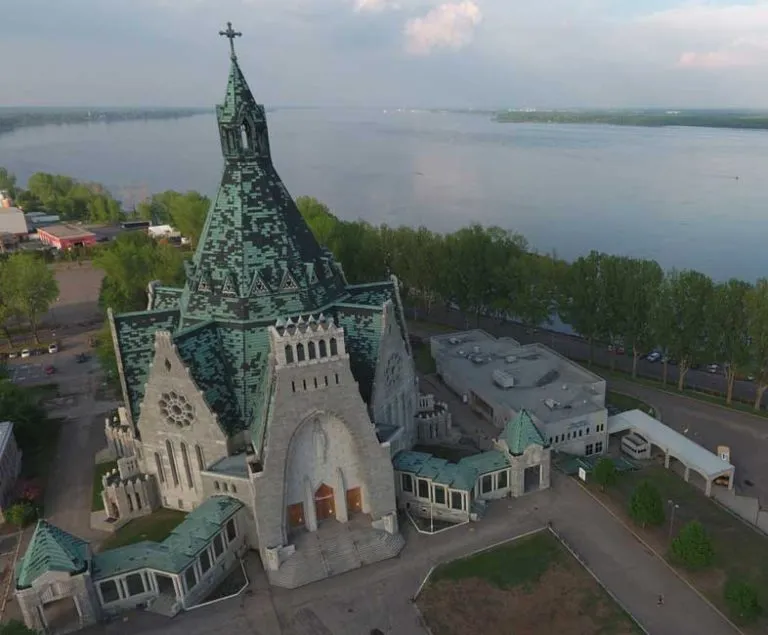
A Religious Awakening – The Power of the Rosary
In 1867 Father Luc Desilets, the pastor at Cap-de- la-Madeleine from 1864 until his death in 1888, had an astonishing experience. Upon investigating a noise he had heard in the church, he found a small pig chewing on a rosary. This was for him a shocking experience. He was saddened by the fact that people were no longer praying the rosary. He remembered the Confraternity of the Rosary that had been established in the parish in 1694.
He then consecrated himself to the Blessed Mother and re-introduced the devotion of the rosary in the parish, praying the rosary after each Mass and encouraging his parishioners to pray the rosary at home. Soon more and more parishioners started coming to church; eventually the church was too small and a larger church was required.
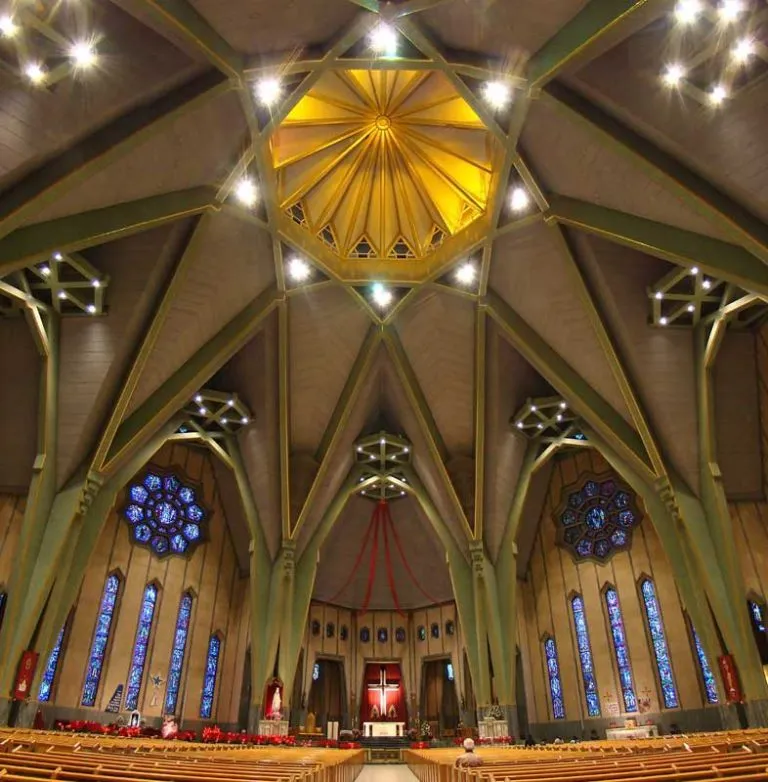
The Ice Bridge – The First Miracle
During Fr. Desilets’ revival of Marian devotion the number of people attending the parish church began to increase until the church was no longer large enough to hold the parishioners. In 1878 it was decided that a larger church was needed and that it would be built with stones from the opposite side of the St. Lawrence River which is approximately 1+1⁄4 miles across at Cap-de-la-Madeleine. The decision was made to bring the stones across the river on sleds once it had frozen in the winter.
Unfortunately the 1878-1879 winter was unusually mild and the St. Lawrence did not freeze over as planned. This seemed to hinder plans for construction of the new church. Fr. Desilets instructed his congregation to pray the rosary in order to obtain ice to cross the river, he also promised Mary that if she interceded he would dedicate the Old Church (then dedicated to Mary Magdalene) to her instead. In March 1879 pieces of ice floated downstream from Lake St-Pierre, forming a “bridge” across the St. Lawrence River, and this miracle was attributed to the intercession of the Blessed Mother.
This bridge was called the Rosary Bridge due to its connection with the prayer of the same name. For several days the parishioners poured water on the ice pieces in order to thicken the ice and form a path, which they then used to transport the stones across the river. Fr. Desilets upheld his promise and renamed the old church.
On June 22, 1888, the old stone church was formally dedicated to Our Lady, Queen of the Most Holy Rosary, and Dorval’s statue ceremoniously relocated from the alcove to above the altar. That evening, while praying in the small church, Father Desilets, Franciscan friar Father Frédéric Janssoone O.F.M, and a parishioner, Pierre Lacroix, all seemed to see the statue open its eyes. This impression continued for five or ten minutes while the two priests moved about the church to view the statue from different perspective to test whether this was an optical illusion.
When word circulated of this unusual occurrence, the incidents of pilgrimages increased. Beginning in 1892, there were reports of cures.
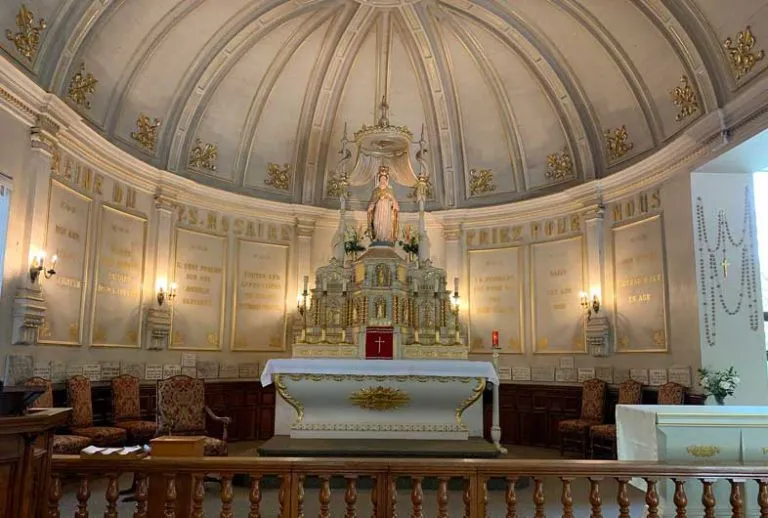
The Miracle of the Eyes – The Second Miracle
On June 22, 1888 the dedication of the small fieldstone church to Our Lady, Queen of the Most Holy Rosary, took place: this was the inauguration of “Our Lady of the Cape Shrine,” (Le Sanctuaire Notre-Dame- du-Cap). During the dedication, the statue that had been donated to the parish by a parishioner in 1854 was ceremoniously placed on the main altar. That evening Pierre Lacroix from Trois-Rivières, a handicapped man, came to pray and asked for the assistance of Father Frederic Janssoone O.F.M., and Father Luc Desilets to help him into the church.
As the three men were praying, suddenly Father Desilets got up to ask Father Frederic if he could see the same thing he was seeing. Father Frederic answered that ‘Yes, the statue has opened its eyes, hasn’t it?’ Pierre Lacroix also noticed this. Both priests got up, moving from spot to spot while still looking at the statue to make sure that they were really seeing this.
Father Frederic often spoke of this event saying that the eyes of the statue were wide opened; that they stayed opened for about five to ten minutes; that her eyes were dark, well-formed and in perfect harmony with the rest of her face; that she had the face of a living person; that her look changed his life forever. He never stopped talking about this wonderful event of the Blessed Mother.

The Missionary Oblates of Mary Immaculate
Two months following the opening of the statue’s eyes, Father Desilets died suddenly and Father Eugene Duguay became the new pastor. As many pilgrims were coming to the Shrine, Father Frederic became its first pilgrimage director. For the next 14 years both priests worked very hard at providing for the parishioners and the many pilgrims.
They asked the bishop for someone to take over the responsibilities of the Shrine. Finally, in 1902 the Missionary Oblates of Mary Immaculate became the guardians of the Shrine. Much work was done following the arrival of the Oblates: landscaping, excavation of a lake, tree-planting, the addition of the monuments of the Rosary, the replacement of the wooden monuments of the Stations of the Cross, the construction of the Rosary Bridge and also the planning and construction of a basilica.
Stained Glass Windows & The Casavant Organ

The construction of the Basilica began in 1955 and it was inaugurated in 1964. It can seat 1660 persons. Its dome rises up to 38 meters high (125 feet). The Basilica is adorned with remarkable stained glass windows by Father Jan Tillemans, a Dutch Missionary Oblate of Mary Immaculate. They are mounted according to centuries old techniques and are an unequalled treasure in North America. The Casavant organ is one of the largest in Canada. Its console is serviced by 5425 pipes. The case work is in the shape of a maple leaf covering the back wall of the Basilica.
Exterior
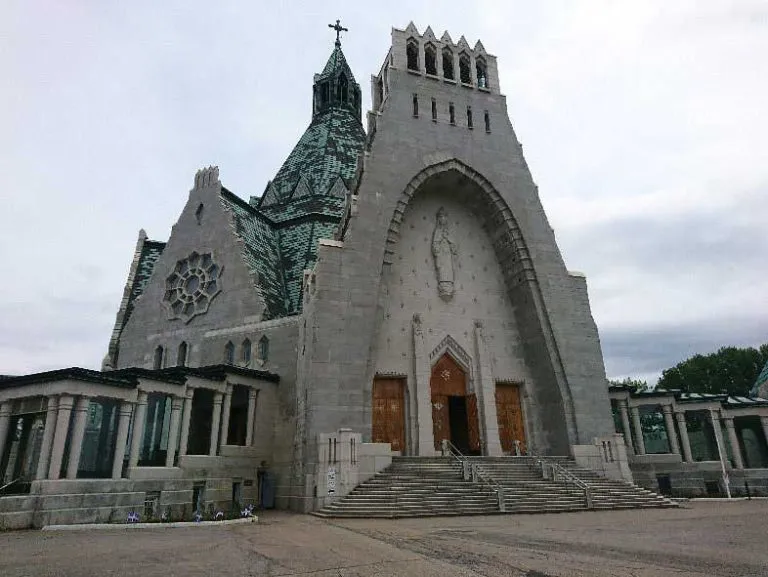
An octagonal-shaped building 79 m (260 ft) long by 60 m (167 ft) wide. The pyramid-shaped dome is surmounted by a skylight which supports a 4.5 m (15 ft) high cross. The top of the cross is 78.5 m (258 ft) from the ground. The Basilica rest on 195 foundation piles driven through sand and clay, to reach solid rock at about 27.5 m (90 ft) deep.
The white granite of the walls comes from Saint-Gerard (Wolfe). The copper of the roof changes color in the long run. The moist air covers it with verdigris. The stylized replica of the statue of Our Lady of the Cape on the facade is the work of Paul Gingras. It is 7.3 m (24 ft) high.
The cornerstone is at the front of the Basilica, at the top of the steps, on the left. The four polished stones embedded in the shape of a cross were among the stones transported on the Ice Bridge in March 1879. They were blessed in Rome by Pope Pius XII.
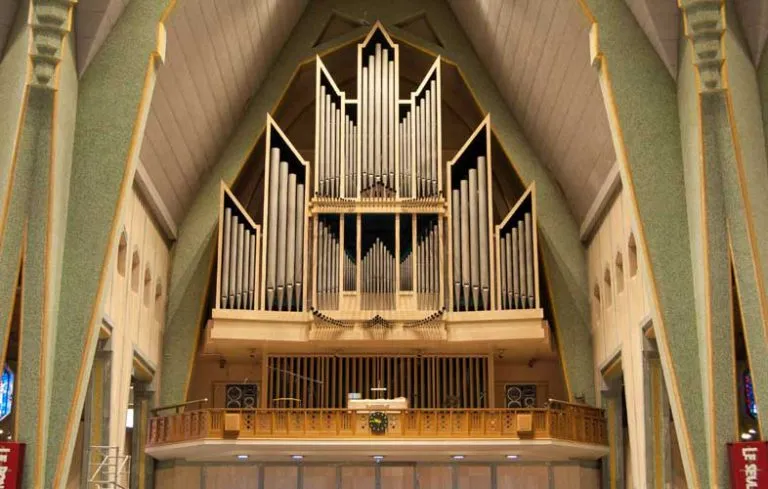
Interior
When entering the Basilica, one is impressed by the volume of the nave and by the harmony of its proportions. One can see everywhere, no columns or pillars to hinder the view of the 1660 people who can take place in the pews.
The framework is formed of large arches of reinforced concrete consisting of oblique straight lines (polygonal arcs) which fall on pillars at the angles of the octagon. The buttresses which are located between le pillars and the walls are pierced with a high opening allowing circulation around the nave.
In the design of the great arches, the choir and the transepts, the architect Adrien Dufresne was obviously inspired by his mentor, Dom Bellot, a Benedictine monk. The arches of the choir and transepts somewhat resemble the angles formed by the phalanges of the fingers when they are folded. It is there, it seems, that Dom Bellot would have gotten his inspiration for the polygonal arches. The inner dome surrounded by triangular windows forms a large golden rim with a diameter of 14.5 m (48 ft).
Altar
The altar table is made of a calacatta marble block with gold veins. It measures 3.35 m (11 ft) and weighs 3 tons. The inscription sanctus, sanctus, sanctus resumes the hymn of praise to god holy, holy, holy. The altar table contains relics of saint perpetua and saint felicite, two young women christian martyrs in carthage (north africa, tunisia today), in 203. Their feast day is march 7th.
On the front of the altar is a mosaic inspired by the Apocalypse, the Lamb and the Book with Seven Seals. The lamb bears the cross, it is the symbol of Christ victorious over death present on the altar when celebrating the Eucharist.

Pilgrimages
In 1904, Pope Pius X authorized a canonical coronation for the statue, which was carried out by Bishop François-Xavier Cloutier. The “shamrock-girdled crown” was provided by the Irish community of Montreal. The image received a second coronation in August 1954 by Cardinal Valerio Valeri, representing Pope Pius XII. Pope John Paul II stopped there in 1984, during a visit to Quebec. This inaugurated a tradition of annual pilgrimages for young people, known as Cap-Jeunesse.
There are many pilgrimages to the shrine, including hundreds by bus from Canada and the United States. At the end of July, members of the Quebec Italian community, stop at the basilica en route to Sainte-Anne-de-Beaupré for the feast of St Anne on July 26.
The Marie Reine de la Paix pilgrims converge every year from several points in Quebec, arriving on August 15, the Feast of the Assumption. Some travel on foot the 150 km from Sainte-Anne-de-Beaupré. Celebrations include torchlight processions and masses and hymns in creole for pilgrims from the Haitian community.
Participants in the Marie Reine Canada pilgrimage, established in 2003, travel 100 km on foot in three days from St.-Joseph-de-Lanoraie (Lanoraie, Quebec), through Maskinongé and Trois-Rivières, every Labour Day weekend.
Feast Day – 22nd June
Annual Feast Day of Our Lady of Hope celebrated on 22nd June.
Mass Time
Weekdays
Sundays
Church Visiting Time
Contact Info
626, Rue Notre Dame E, Trois-Rivières,
Quebec, QC, G8T 4G9, Canada
Phone No.
Tel : +1 819-374-2441
Accommodations
How to reach the Sanctuary
Québec City Jean Lesage International Airport, also known as Jean Lesage International Airport, in Quebec City, Canada is the nearby Airport to the Sanctuary.
Shawinigan Train Station in Shawinigan, Quebec, Canada is the nearby Train Station to the Sanctuary.

